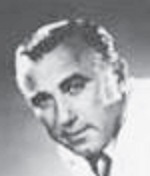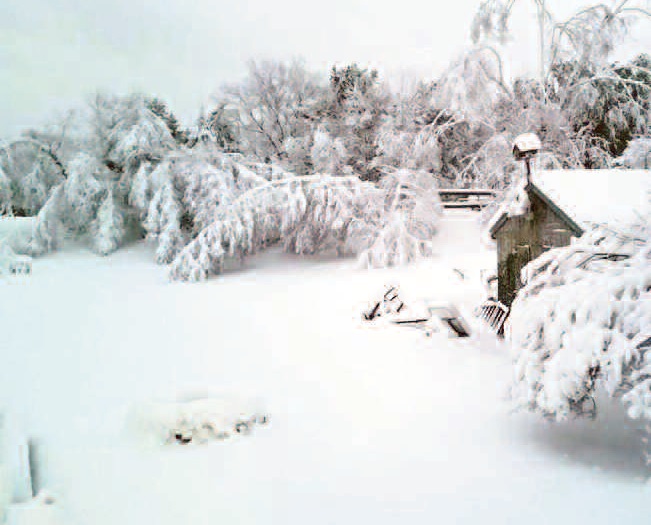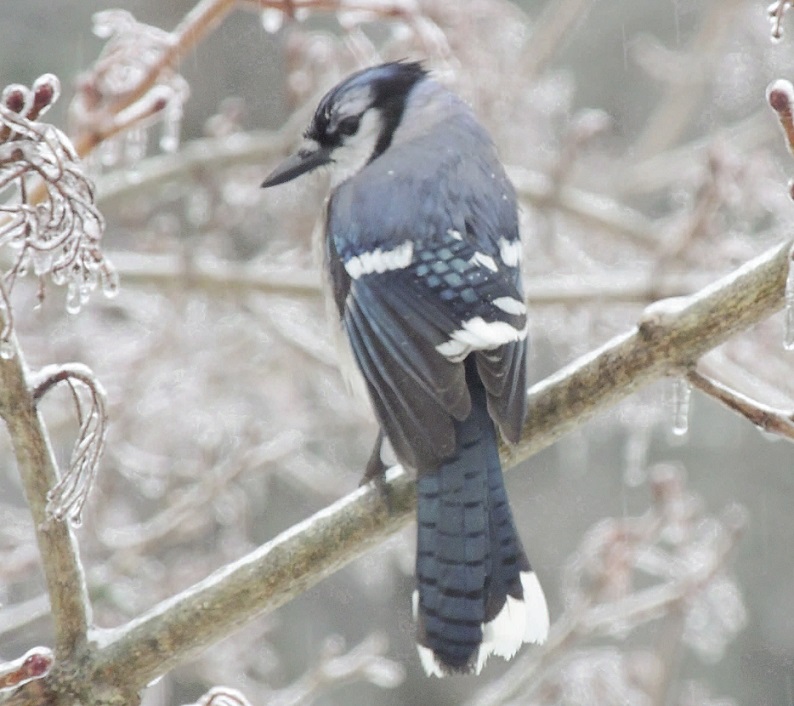by Danny W. Howard
Now I know there are some folks out there who, for some reason, think that I have the tendency to stretch the truth every now and again. I don’t hardly know where they got that from. Why I say about half of what I write is the gospel truth, and if it ain’t may lightning strike me down where I stand – that’s funny. I thought I just heard some thunder.
Now, you take what happened to me one day last summer. I was out mowing the lawn with my old lawnmower. Now I have to state that my lawn is perhaps the best cared for bunch of crab grass, dandelions, and assorted weeds in nearly the whole state of Maine. Though I should think there are others out there who would make a like claim.
I had, over the years, tried to smooth over some of the rough spots in my lawn that were made by bulldozers, dump trucks and those places where the snowplow digs into the ground before and after the ground freezes and thaws.
I must say I think I did a good job of it – except this one spot over by the pair of pear trees that one of my neighbors gave me back in – let’s see 19–, 1980-something.Wow, that was a long time ago, wasn’t it?
Well, anyway, like I was saying, I had the lawn pretty much leveled off except this one little spot about, say 20 feet around out there by them pair trees. It had waist high weeds and those hardhack bushes. They were called hardhack bushes because they were hard to hack.
Well, I was running my old lawnmowers over the area when I noticed the handles of the lawnmower were growing up over my head. Now, I want to tell ya – I thought that was a mighty strange thing for an old lawnmower to be doing, so I stopped my mowing for a while to investigate the situation. To my relief I found that the handles weren’t growing but I was standing in a hole that seemed to be getting deeper by the second. The ground came shooting right by my eye balls as I dropped into the aforementioned hole. Now, as I recall it, I must have reached the bottom of this hole a whole half second later, because that’s when I felt this rather sharp pain in my feet. Now this pain traveled up my legs and made an impression on my knees. And then tried to dislocate my hips from the rest of my body before distributing the pain throughout my body before exiting through every one of my hair tips. Where the pain went after that I didn’t know, I kind of lost interest at that point.
As near as I could figure out, I had found the old well that the deed said was on the property when we bought the land from that old couple almost 20-, no, 40 years ago.
So, here I am at the bottom of a, oh, I guess 20-foot hole, with bits of rotten wood, rocks, dust and clumps of dirt falling on my head – from the top of the hole.
My first concern was if I was still alive, I moved and found out that I was indeed alive, the dead don’t feel pain, so I am told, I can’t imagine how they reached that conclusion. What did they do, kick a dead person, and he didn’t say “Ouch!?”
I was standing up and touched the rocks that made up the walls of this well, that I was at the bottom. I figured my chances of getting out of this well were as great as having fallen into it in the first place. So, I started hollering to my wife. Now, at this point, I’ve changed her name to protect the innocent. “Susan—Susan—Suussaann,” I calmly hollered. Susan (my wife’s name for this story) comes to the hole and looks down, sending more rocks, dirt, pieces of rotten boards and grass clumps down on me.
“Oh, there you are, dinner’s ready! What’re doing down there? Do you need some help? Do you want me to call the fire department?”
“Yes, I’m fine. Thanks for asking. And, at the moment, I am not hungry. I fell, yes, I need help and no, don’t you dare call the fire department! And, please, step away from the edge. Can you get me the ladder?”
“I think I’d better call the fire department.”
“No!. No fire department.” Now, as an afterthought, as much as I hate to admit it, calling the fire department would have been a good idea, in fact, a great idea.
But I am getting ahead of the story.
So, she gets the ladder. “I better tie a rope on the ladder so I can pull it up if this doesn’t work,” she said.
Her concern for my well-being was, I thought, touching. After much pushing and pulling, plus a few wheelbarrows full of rotten boards, rocks, dirt and clumps of grass down on my head, I had the ladder down the well and what I thought was fairly solid ground at the bottom of the well.
Fire department? Who needs the fire department, as I started up the ladder out of my tomb – er, well. As I was climbing up the ladder I noticed a pretty shaped rock. I thought, Gee, I’ve come up the ladder at least four rungs and this same rock is still at eye level. It was at this point that I realized the ladder was sinking into the bottom of the well. The ladder suddenly stopped with a jar, as it seemed that my wife had the forethought to tie the rope to something solid at the surface.
She looked down at me and said something like, “Hang on, honey, I’ll get you out!”
I’m thinking, now how is she going to get me out of this well while I’m holding on to the ladder? Then, I heard the van start up.
I realized what she had in mind and calmly yelled, “No, not that – stop, before you kill me!”
Those words had no sooner left my lips when I shot out of the well with the ladder in tow – somehow the ladder had managed to shoot out of the well most of its length with only about four or five feet still in the well. The ladder was bending toward the ground. I was calmly shouting to my wife to stop before the rope broke, but my voice was being drowned out by the roar of the van and the spinning tires on the gravel driveway. Why, there was so much noise that I hardly heard the rope break and zap by my left ear.
At this point, things started to happen rather quickly so if I get mixed up, please forgive me.
After the rope broke, the bend in the ladder straigthened up in a hurry, throwing me first into the straightening ladder with just enough force to jar a few of my fillings loose in my teeth. The bad news is that I lost my grip on the ladder that was just beginning its spring in the opposite direction from what I was traveling.
That threw me nearly over the pear tree. Its upper-most branches doing their best to catch me. I guess it must have slowed me down enough for the black raspberry bushes to break my fall. I painfully laid there for my thoughts to catch up with me. As I took note of my injuries, I noticed a sharp pain between my eyes. I felt my forehead. It had been replaced by a rather large goose egg. That was most likely caused by me hitting the ladder as it sprung backwards.
My wife came running over to see if there was any damage done to the ladder, then asked if I was OK.
“Peaches and cream,” I said, “now help me up.”
Well, after all of that, she reached down and helped me up, and wouldn’t you know it, she starts giggling.
“This—is—not—funny!” I said.
“Yes (giggle) it—is (giggle),” she giggled.
Now, you know why I didn’t want the fire department here. It’s bad enough my wife – but the whole town?
Then, I remembered something very important that came to mind that I wanted to tell my wife. It came to mind when I was flying over the pear tree. I said to her, “You get the keys to the van?”
“Why yes, they’re right here,” she said.
“Give them to me!”
“Why, are you going somewhere?” as she handed me the keys.
“No, I ain’t going anywhere now,” as I put the keys in my pocket.
She started to giggling again.
“Women!”
I started to get the ladder and the rope together, and tied one end of the ladder and the other end to the pair tree. I then placed the ladder back down the well.
“What are you doing,” my wife asked. She wasn’t giggling anymore.
“I am going down to look around,” I answered.
“Why?”
“Aren’t you the least bit interested as to why they covered over the well like that?” I asked.
“No.”
“Well, I am,” I said.
She looked at my head and the goose egg that was there, and said, ”I think you got whacked harder than you think.”
“I’m OK, now be a dear and get me the flashlight.”
All of this activity had gotten the attention of my next door neighbor and he came over.
“You know if you’re going down there you ought to have a backup for that flashlight. I’ve got some road flares – I’ll go and get tone,” he said. He returned in a few minutes and handed me the flare.
“What you do it take off the cap and strike it like a match.”
OK, take off the cap and strike it like a match, got it.
“And be sure to strike it away from your face.”
“Away from the face. Got it.”
I went down the ladder with the flashlight and the backup road flare.
Down at the bottom of the well, I noticed another layer of boards covering a hole. I pulled away some rotten boards and noticed there was a cave there. Well, a big crack in the ledge. I got into the crack and did some looking around. At that point the flashlight starts to fade I can’t see three feet in front of me, so I grabbed the flare and pulled off the cap. When I was ready to strike it, I heard this noise, like a flock of birds all taking off at once. All at once the cave is full of bats – in what seemed a mad rush to leave the cave – like rats off a sinking ship. Mmmmm, I go.
At about the same time, my next door neighbor tells my wife something about methane gas in caves down south, but I didn’t think that’ll be a problem this for no – BOOM!
I guess I was wrong, as he picks himself up, and helped my wife get up.
The rocks, dirt and clumps of grass that were thrown out of the well had settled down by the time they got to the edge of the wall and looked down.
“Are you OK?” they asked.
“What?” I could see their lips moving, but no sound.
“Oh, my God,” she told me later. I looked down that well and saw you leaning against the wall of the well, and she asked herself, “Why did I take off my shirt? Then, I realized you didn’t have any hair on your head. I thought maybe you didn’t ‘take’ your shirt off. I’ll go and get you some pants.”
Well, long story short, we fixed up the entrance cleaned away the loose dirt and rocks and sold tickets to what would become the Mammoth Cave of the North.
Now, like I said, most of this is true – of course, I may have exaggerated bits and pieces here nd there just to make the story more interesting, but may lightning strike me down if this ain’t the truth.
Mmmm, must be a storm coming. I think I just heard some thunder.
Danny Howard is a resident of Augusta.


 by Peter Cates
by Peter Cates








 by Roland D. Hallee
by Roland D. Hallee


 by Milt Huntington
by Milt Huntington